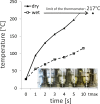Vapours of US and EU Market Leader Electronic Cigarette Brands and Liquids Are Cytotoxic for Human Vascular Endothelial Cells
- PMID: 27351725
- PMCID: PMC4924852
- DOI: 10.1371/journal.pone.0157337
Vapours of US and EU Market Leader Electronic Cigarette Brands and Liquids Are Cytotoxic for Human Vascular Endothelial Cells
Abstract
The present study was conducted to provide toxicological data on e-cigarette vapours of different e-cigarette brands and liquids from systems viewed as leaders in the e-cigarette market and to compare e-cigarette vapour toxicity to the toxicity of conventional strong high-nicotine cigarette smoke. Using an adapted version of a previously constructed cigarette smoke constituent sampling device, we collected the hydrophilic fraction of e-cigarette vapour and exposed human umbilical vein endothelial cells (HUVECs) to the mixture of compounds present in the vapour of 4 different single-use e-cigarettes, 6 different liquid vapours produced by the same refillable e-cigarette, and one e-cigarette with an exchangeable liquid cartridge. After incubation of cells with various concentrations and for various periods of time we analysed cell death induction, proliferation rates, the occurrence of intra-cellular reactive oxygen species, cell morphology, and we also measured e-cigarette heating coil temperatures. Overall, conventional cigarette smoke extract showed the most severe impact on endothelial cells. However, some e-cigarette vapour extracts showed high cytotoxicity, inhibition of cell proliferation, and alterations in cell morphology, which were comparable to conventional high-nicotine cigarettes. The vapours generated from different liquids using the same e-cigarette show substantial differences, pointing to the liquids as an important source for toxicity. E-cigarette vapour-mediated induction of oxidative stress was significant in one out of the 11 analysed vapours. There is a high variability in the acute cytotoxicity of e-cigarette vapours depending on the liquid and on the e-cigarettes used. Some products showed toxic effects close to a conventional high-nicotine cigarette. Liquid nicotine, menthol content, and the formation of acute intracellular reactive oxygen species do not seem to be the central elements in e-cigarette vapour toxicity.
Conflict of interest statement
Figures




References
-
- Geiss O, Bianchi I, Barrero-Moreno J. Correlation of volatile carbonyl yields emitted by e-cigarettes with the temperature of the heating coil and the perceived sensorial quality of the generated vapours. International journal of hygiene and environmental health. 2016;219(3):268–77. 10.1016/j.ijheh.2016.01.004 . - DOI - PubMed
MeSH terms
Substances
LinkOut - more resources
Full Text Sources
Other Literature Sources
Medical

